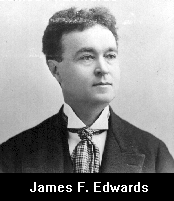History of the University Archives
Father Edward Sorin, the founder of the University of Notre Dame, in effect also founded the University Archives when he directed that the charters granted to the University and its manual labor school should "remain in the archives as the most precious monuments that could be in its possession" (The Chronicles of Notre Dame du Lac). By recognizing that certain precious documents needed to be preserved in a safe place, Father Sorin planted the seed that after many years and a succession of archivists grew into the Archives as we know it today.
First among the prominent people who have worked to shape the Archives and its collections was James F. Edwards. In the nineteenth century, Notre Dame offered elementary and preparatory courses in addition to collegiate work. Edwards arrived in 1859 at age nine and remained at Notre Dame until his death fifty-two years later. Starting in 1876, he served Notre Dame as a history professor and later as its librarian.
 Edwards began acquiring material during his undergraduate years and continued this activity throughout his life. He wanted to acquire mementoes of the American Catholic hierarchy. He imagined the creation of a Bishops' Memorial Hall containing a portrait of, a vestment from, and a manuscript by every bishop in the United States. He actually managed to acquire much more than he originally set out to collect. He set up his Bishops' Memorial Hall in the hallways of the Main Building at Notre Dame and displayed many objects from the collection at the 1893 World's Columbian Exposition in Chicago. Along the way he found that many bishops had no interest in maintaining records of their own correspondence; some willingly turned all their papers over to him. These papers became some of the first manuscript collections held in what he called “The Catholic Archives of America.”
Edwards began acquiring material during his undergraduate years and continued this activity throughout his life. He wanted to acquire mementoes of the American Catholic hierarchy. He imagined the creation of a Bishops' Memorial Hall containing a portrait of, a vestment from, and a manuscript by every bishop in the United States. He actually managed to acquire much more than he originally set out to collect. He set up his Bishops' Memorial Hall in the hallways of the Main Building at Notre Dame and displayed many objects from the collection at the 1893 World's Columbian Exposition in Chicago. Along the way he found that many bishops had no interest in maintaining records of their own correspondence; some willingly turned all their papers over to him. These papers became some of the first manuscript collections held in what he called “The Catholic Archives of America.”
The task of making these manuscripts available for research use would fall to Edwards’ successors, as he did not show much interest in preparing systematic inventories or descriptions of the manuscripts he collected. After Edwards’ death in 1911, Rev. Paul Foik, C.S.C., began the laborious process of describing Edwards’ Catholic Archives. It would later become the life’s work of Rev. Thomas T. McAvoy, C.S.C., to organize these manuscript collections into a world-renowned repository for scholarly research. Archivist from 1929 until 1969, McAvoy matched and then exceeded Edwards’ reputation as a collector. He acquired significant new manuscript collections documenting a far wider swath of the American Catholic experience than interested his predecessors. When he could not lay hold of original material for permanent retention at Notre Dame, he instituted a program to microfilm material found elsewhere, particularly the extensive records of the archives of European mission societies and the Congregation for the Propagation of the Faith in the Vatican.
It would remain for those who followed McAvoy, however, to transform what was still primarily a repository of manuscript collections, documenting a diverse array of Catholic activities in America, into a functioning institutional archive of University records as well. Rev. Thomas Blantz, C.S.C. was pressed into service as University Archivist in 1969 when Father McAvoy collapsed and died unexpectedly in his office. Juggling duties as Archivist, University Vice President, and a member of the teaching faculty, Blantz ably continued McAvoy’s efforts to make Notre Dame the nation’s most important location for undertaking serious research into the American Catholic experience. However, he also saw what neither McAvoy nor any of his predecessors had seen: the absence of an actual institutional archive. Rare and precious individual records and the correspondence files of the presidents were important, but their preservation alone was not enough to warrant use of the term “archives” to describe the unit charged with their care. Blantz instituted a major shift in custodial perspective, recognizing the need to stop treating University records like manuscript collections and instead designate administrative record groups as official components of the Archives’ holdings.
Wendy Clauson Schlereth, Blantz’s successor in 1978, built upon Blantz’s foundation and hired a staff trained specifically in archival administration. Over the next decades she worked to systematize the collection of University records by implementing records management practices that would ensure the orderly flow of historically significant institutional records into the Archives. Photographs and records of Notre Dame sporting activities and campus life augmented the holdings of the Archives and dramatically changed the nature and number of reference services. Complemented by an aggressive acquisition program to maintain the stature of the Archives’ manuscript collections, which was aided by direct, personal appeals from Rev. Theodore Hesburgh, C.S.C. during his presidency, the University Archives in the final quarter of the twentieth century was transformed into a modern, professional research facility. Material produced by new technology added to more traditional paper records, and advancing technologies were then employed to provide more and better access to the contents of all the collections. The Archives of the University of Notre Dame at last became a true University archives, in fact as well as title.
This page was last updated January 23, 2020

